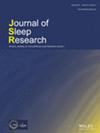Respiratory safety of lemborexant in adult and elderly subjects with moderate‐to‐severe chronic obstructive pulmonary disease
IF 3.4
3区 医学
Q2 CLINICAL NEUROLOGY
引用次数: 0
Abstract
SummaryBecause some hypnotics worsen respiratory conditions, it was important to determine the respiratory safety of lemborexant, a competitive dual orexin‐receptor antagonist approved to treat adults with insomnia, in subjects with moderate‐to‐severe chronic obstructive pulmonary disease. E2006‐A001‐113 (Study 113; NCT04647383) was a multicentre, multiple‐dose, randomised, double‐blind, placebo‐controlled, two‐period crossover study in adult subjects with moderate or severe chronic obstructive pulmonary disease (per spirometry‐based Global Initiative for Chronic Obstructive Lung Disease [GOLD] criteria). Subjects (在患有中度至重度慢性阻塞性肺病的成年和老年受试者中使用苯溴索的呼吸安全性
摘要由于某些催眠药会加重呼吸系统疾病,因此必须确定lemborexant(一种获准用于治疗成人失眠症的竞争性双奥曲肽受体拮抗剂)在中度至重度慢性阻塞性肺病患者中的呼吸系统安全性。E2006-A001-113(研究 113;NCT04647383)是一项多中心、多剂量、随机、双盲、安慰剂对照、两阶段交叉研究,研究对象为患有中度或重度慢性阻塞性肺病(根据基于肺活量测定的全球慢性阻塞性肺病倡议 [GOLD] 标准)的成年受试者。受试者(N = 30)被随机分配到两个治疗序列,包括 8 夜治疗期(冲洗期≥ 14 天),分别服用 10 毫克的伦博雷沙坦或安慰剂。单次(第1天)和多次(第8天)用药后,对外周血氧饱和度(SpO2;主要终点)、呼吸暂停-低通气指数、客观睡眠参数和睡眠结构测量进行了评估。单次服用伦博雷沙坦(91.1%)与服用安慰剂(91.5%)后,最小二乘平均SpO2无明显差异。虽然在多次给药后观察到 SpO2 存在统计学意义上的显著差异(最小二乘法平均值:伦博罗司特,91.3%;安慰剂,90.8%),但这并不具有临床意义。单次或多次用药后,呼吸暂停-低通气指数在不同治疗之间没有显著差异。在第1天和第8天,总睡眠时间和总快速眼动睡眠时间明显多于安慰剂。服用伦博雷沙坦的受试者中有5人(16.7%)报告了治疗突发不良事件,服用安慰剂的受试者中有4人(13.3%)报告了治疗突发不良事件;治疗突发不良事件大多较轻。与安慰剂相比,中度至重度慢性阻塞性肺病患者在单次和多次服用伦博雷沙坦后耐受性良好,不会对SpO2或呼吸暂停-低通气指数产生不利影响。
本文章由计算机程序翻译,如有差异,请以英文原文为准。
求助全文
约1分钟内获得全文
求助全文
来源期刊

Journal of Sleep Research
医学-临床神经学
CiteScore
9.00
自引率
6.80%
发文量
234
审稿时长
6-12 weeks
期刊介绍:
The Journal of Sleep Research is dedicated to basic and clinical sleep research. The Journal publishes original research papers and invited reviews in all areas of sleep research (including biological rhythms). The Journal aims to promote the exchange of ideas between basic and clinical sleep researchers coming from a wide range of backgrounds and disciplines. The Journal will achieve this by publishing papers which use multidisciplinary and novel approaches to answer important questions about sleep, as well as its disorders and the treatment thereof.
 求助内容:
求助内容: 应助结果提醒方式:
应助结果提醒方式:


